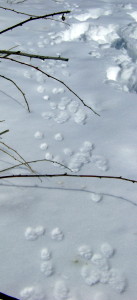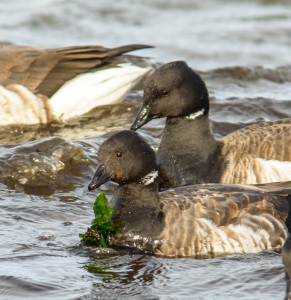Sea ducks stay warm at Sachuest

Dr. Bob Kenney (foreground in orange cap), volunteer guide with ASRI, discusses bird sightings with the group.
If you haven’t already done so, please take a moment to “follow” Science and Nature for a Pie on Facebook. You’ll get photos, facts, and updates on the natural world: facebook.com/scienceandnatureforapie.
It’s been the kind of winter where following statement will seem ludicrous: there was sunshine at Sachuest Point National Wildlife Refuge for a recent Audubon bird walk. Not only that, but there was no wind. None. A coastal location in the depths of one of the most miserable winters in 20 years, and the biggest problem was a lack of sun block. Amazing. And yet, there we were, a tidy group of about a half dozen birders, bundled and bustling along behind Audubon Society of Rhode Island (ASRI) leader Dr. Bob Kenney.
Sachuest is a 242-acre parcel of land along the rocky coast of Middletown.
According to the website (http://www.fws.gov/refuge/Sachuest_Point), the land has been used for such diverse purposes as farming, sheep grazing, and military rifle training. After a 70-acre donation of land from Audubon in 1970, the area became a national wildlife refuge, and today is popular with birders, fishermen, and walkers.
Despite the voluminous amount of snow on the ground, most of the trails are well packed, making walking fairly simple. The initial segment of the walk is bordered by heavy brush, with breaks in between. The center of the path is packed with boot prints, some with evidence of devices to aid in gaining traction. Just to the side of those are the unbroken lines of cross country ski tracks from those who make it out the point while the snow is still fresh. The circular marks from their poles look like some odd hoof print from a new species of animal.
Finally, along the entire length of trail, are paw prints. Hundreds of them, moving in and out of the thickets. Their traces bring them out from the brambles, but stop just below the lowest hanging ridge of branches. In this way, animals such as mice and rabbits use this as a kind of animal highway. Stopping at the edge of the branches allows for freer movement while still maintaining cover from roaming predators like harriers. Amid the prints are tiny piles of husks from seeds of the surrounding plants, along with stains from passing those seeds through animal digestive systems.
Toward the interior of the property, the birds are feasting away on the seeds of staghorn sumac. Robins and Downy Woodpeckers perch delicately on the maroon clusters of berries produced in September. The branches of the sumac are sometimes covered with a fuzz, and this, plus the way the larger branches separate, give the staghorn the association with a deer’s velvet antlers.
At the first observation platform, we train our binoculars to the ocean. The cove to the left of us has been frozen for who knows how long. The cold has been so low and so consistent that even salt water freezes if it doesn’t move enough. What was once a cove is now a field of snow. The edge, though, the part near the ocean, is a mix of water and ice, like the crushed ice from a vending machine and swirled in a plastic cocktail cup. Along that edge and near the rocks that form the shore below us, swim a group of what are broadly called diving ducks. They bob, paddle, and dive in the ocean water like they were in a pool in summertime.
Delightful as the weather was that day, it’s safe to say we would have declined any invitation to join the feathered crew below us. At this time of year, thousands of ducks have migrated to the New England coastline from their homes in the Arctic to be near open water and milder (by their standards) weather. Some, like the Common Loon, normally inhabit fresh water. Of course, if it’s cold enough for salt water to freeze here in Rhode Island, it isn’t hard to picture the northern lakes favored by the loon being inhabited by no one but ice fishermen, and even they are unlikely to stay long without liquid antifreeze. But how on earth do the ducks stand swimming, even diving in brutal temperatures?
Two of the reasons can be observed in a duck’s behavior. Many ducks seem pathologically obsessed with their appearance, constantly preening and fussing. This behavior, however, is entirely different from that of the average teenage obsession with appearance. In fact, it is not related to appearance at all.
Ducks will often curl their necks all the way to the base of their tails, then rub their heads all over their bodies. What they’re doing is actually waterproofing themselves. Ducks have a preen gland that secretes an oil. As they reach back, they get some of the oil on their heads, and proceed to spread it all around their bodies. This seals their feathers, preventing any of that icy cold water from reaching them.
Inside that coating of oil are the feathers. Feathers come in different shapes and serve different purposes. Arguably most important to the ducks at this time of year is their down. A down feather has no vein, the thin, hard substance that gives a feather its stiffness. The fluffy nature of down allows it to be remarkably dense. In addition, down, along with other feathers, is comprised of three sections: barbs, the “branches” or main segments that splay outwards. Barbules are branchlets, which stick out from the barbs. And tiniest of all are the hooklets. Viewed under a microscope, these hooklets act like Velcro. When a duck or other bird preens, it is “zipping” barbules back together, allowing the feather to function to its fullest. In the case of down, preening seals in warmth, maintaining the duck’s internal temperature of roughly 104 degrees.
As we wend our way through the paths of Sachuest, talk is as much about how good the sun feels on our faces as about the Red Breasted Mergansers, the Brant, or the Black Ducks. If the binoculars were reversed, though, one can’t help but wonder what the ducks feeding and swimming happily in the freezing temperatures would make of the humans waddling along in their bulky coats and craning their faces toward the sun. Who is better off in winter?










